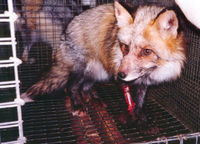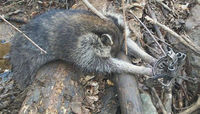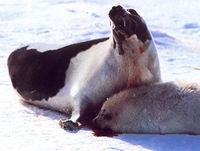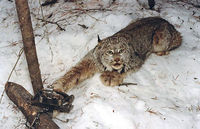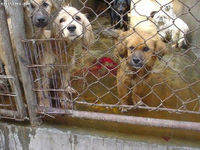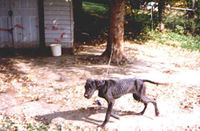War on Animals
War on Animals is an introduction to the animal rights and welfare issues. For animal testing issues, see also animal testing. For animal issues relating to U.S. government subsidies, funding, inspections, animal testing requirements and military testing, see also U.S. Government's War on Animals. For farm animal issues in relation to human health and the environment, see also meat & dairy industry. For commercial dog breeding, see also puppy mills. For humane groups, protests, boycotts and general observance days and weeks, see also Humane Movement. For U.S. legislation, see also U.S. animal rights legislation.
Contents
Faqs
The number of U.S. animals killed for fur annually is approximately equal to the human population of Illinois. The number of U.S. animals used for animal testing annually is approximately equal to the population of Texas. The number of U.S. birds and mammals slaughtered for food annually is approximately equal to 1 and 2/3rd's of the earth's human population. [1]
Animals raised & hunted for food (subsection)
See also animals raised & hunted for food.
Horses
Horse slaughter
Horses going to slaughter are shipped on crowded, double-decker cattle trucks without food, water or rest for over 24 hours. Pregnant mares, foals, injured and blind horses are shipped for slaughter. Under cover footage obtained by the Humane Society of the United States (HSUS) shows fully conscious horses being shackled and hoisted by their rear leg to have their throats slit. It is particularly difficult to align them to the captive bolt gun that renders them unconscious, since horses are skittish by nature. According to the U.S. Department of Agriculture (USDA), 92.3% of horses sent to slaughter are not in danger of abandonment or neglect. The remaining 7 to 8% may require rescue or have to be placed into one of over 400 horse rescues and sanctuaries in the U.S. or simply be humanely euthanized. According to HSUS, it is market forces which dictate the horse slaughter industry. At least 5,000 horses have been imported into one of the three foreign-owned slaughter plants in the U.S. since August of 2004. In California, where horse slaughter was banned in 1998, there was no corresponding rise in cruelty and neglect cases. However, horse theft dropped 34% after the ban. There are hundreds of equine rescue and retirement facilities which rescue horses from slaughter. The New York Racing Association sponsors the Ferdinand Fee for retired racehorses in honor of Ferdinand, a former Kentucky Derby winner who went to slaughter. [2]
Industry generated reports
There are also erroneous, sensationalized reports generated and circulated by horse slaughter lobbies and proponents. For example, within a week of the recent closing of two Texas horse slaughter plants, after a long battle over a 1949 law prohibiting the sale of horse meat; a "shocking investigative report" was published around the world under such titles as "Kentucky, land of the thoroughbred, swamped with unwanted horses"! The article was based on privately owned horses observed free grazing at a reclaimed strip mine in Eastern Kentucky. Kentucky state officials from police and animal control immediately debunked the story. However, it raised such a furor that state governor Ernie Fletcher felt compelled to issue a letter describing the article as "filled with inaccurate statements and information". [3]
Premarin & horse slaughter
Premarin is a drug derived from pregnant mares’ urine (PMU), is prescribed for "symptoms of menopause". Despite the availability of humane and safer alternatives, Premarin is among the most widely prescribed and profitable drugs in America. The urine is collected from mares confined in barns on over 70 "PMU ranches" in the U.S. and Canada. The industry is "self-regulated" through Pfizer's "Code of Practice". Mares in Premarin production commonly suffer from abrasions, leg swelling, excessive boredom, stress, and early death. Strapped to urine collection bags six months out of the year; they are tied to stalls too narrow to turn around or lie down in and are denied free access to water. There is no minimum code of practice for exercise or even that they be exercised at all. After 8 or 9 years of foaling they are sold to slaughter (normal life expectancy is 20 to 25 years.) Every year thousands of PMU foals are sent to auction and sold to slaughter for meat markets in Europe and Japan. [4], [5]
In a shameless bid for public damage control, the company actually prohibited contract PMU ranchers from working with rescue groups. The rationale being that these abused, neglected horses, who along with their foals, are destined for slaughter; do not need to be rescued. [6] See also Premarin.
Rodeos & horse slaughter
Sending horses to slaughter is nothing new to the rodeo industry. Dr. C.G. Haber is a veterinarian who worked for 30 years as a slaughterhouse inspector and saw scores of animals from rodeos sent to slaughter. Although toughened to animal suffering, the condition of rodeo animals sickened him. He describes them as:
- "So extensively bruised that the only areas in which the skin was attached (to the flesh) were the head, neck, leg, and belly. ...I have seen animals, with six to eight ribs broken from the spine and at times, puncturing the lungs. I have seen as much as two to three gallons of free blood accumulated under the detached skin. Bullfights are merciful compared to rodeos. It's high time this cruel sport be outlawed in the United States." [7]
Animals in entertainment
Elephants, bears, tigers and other animals used for entertainment in circuses, rodeos and zoos are often abused by their trainers. They also suffer from loneliness, boredom and frustration from being locked in tiny cages or chained and abused by trainers, they suffer from extreme loneliness, boredom, and frustration from being locked in tiny cages month after month while traveling from city to city in Circuses, etc. Animals are loaded on and off trucks and into "storage areas", like furniture. [8]
Former Las Vegas entertainer and animal trainer Bobby Berosini, sued People for the Ethical Treatment of Animals (PETA), another animal rights group and three individuals after a dancer secretly videotaped him shaking, punching and hitting his orangutans with a rod in the Stardust Hotel in 1989. Nevada's Supreme Court ruled that the tape was an accurate portrayal and not defamatory since Mr. Berosini justified his behavior. [9], [10]
Animals used for clothing
Fur ranches
Most fur-bearing animals are raised in fur ranches with as many as 100,000 wild animals in a single facility. They are kept in cramped, dingy, waste soaked cages where many suffer or perish from dehydration, starvation, disease or self-mutilation. These animals do not receive even minimal protections, as the handling and killing of cage raised, fur bearing animals is not regulated by any U.S. laws. Many ranch raised animals are anally or vaginally electrocuted. A metal conductor is lodged in the animal's throat and an electric prod is shoved inside the rectum, transmitting a 240 volt shock. The conscious animal convulses for two or more minutes before succuming to a massive heart attack. To minimize expenses, animals have their necks broken; are injected with strychnine or asphyxiated with carbon monoxide from engine exhaust. 90% of fur used for trim comes from foxes. As of 2000, over 4.3 million foxes were killed and skinned for their furs annually, world wide. Scandinavia kills about 60% of the world's ranched foxes, with Finland leading the way at 2.1 million annually. [11]
Trapping
Every year approximately 10 million animals are trapped for their fur. Primary tools are the leg hold trap, the body grip (Conibear) trap and the wire snare. [12] Although the U.S. only supplies around 2% of fur ranched fox fur, thousands of foxes in the U.S. and Canada are trapped every year in barbaric steel leg hold traps. Millions of coyote, raccoon, bobcats and other species are caught in the wild using spring traps with metal teeth that shatter their bones. Animals can linger in excruciating pain for days on the trap line without water or food until the trapper returns to crush, shoot, suffocate or drown them. Two to 10 times as many non target animals (dogs, cats, deer, birds, livestock) are caught in the traps. About one quarter of trapped animals escape by chewing their own limbs off. [13]
Leg hold traps have been banned in 88 countries. In spite of irrefutable evidence of cruelty, mutilation and dangers to non-target animals and children; they have only been banned in 8 states. 74% of Americans oppose the leg hold trap, yet Congress has not banned them thanks to the fur industry and lobbies like the American Veterinary Medical Association (AVMA). [14] In a public relations motivated move, the industry began manufacturing traps with a rubber strip across the jaws. However, these traps still close with the same force. In the up to 3 days it may take for a trapper to return, an animal may suffer or die of dehydration, blood loss, hypothermia, trap inflicted injuries or predators. A 1995 study of coyotes trapped in padded leg hold traps found that 97% experienced severe leg swelling and 26% lacerations and fractures. A study of 55 red foxes found that 25 suffered severe swelling; 23 severe lacerations; 17 fractured their teeth and 13 suffered severed tendons, abrasions or fractures. "Drowning sets" are designed to kill beaver, muskrat and mink. Animals in these traps struggle for an average of 9 1/2 minutes and a beaver may hold out as long as 20 minutes. [15] See also AVMA, section 1.
Asian imports: dog & cat fur
Over two million dogs and cats are slaughtered each year for their furs and skins, mostly in China and other Asian countries. China produces 85% of the world's fur and has no animal welfare laws. A Swiss Animal Protection Agency documented the slaughter of millions of dogs and cats being bludgeoned, hanged, bled to death, and strangled with wire nooses. Investigators documented 50,000 to 100,000 cat pelts stockpiled at animal byproduct factories in China. At least ten dogs are slaughtered to make a single coat, more if puppies are used. Up to 24 cats are slaughtered to make one fur coat. Dog and cat fur is used in trims, linings, hats, decorative figurines, and folk remedies. Skins are used in dog chew toys and shoe leather. Since 1997, the Humane Society of the United States and Humane Society International (HSI) have investigated the international fur trade from Asian countries to wholesalers in the U.S., Russia and the European Union. In the Asian fur trade, cats are strangled inside their cages as other cats look on. Dogs are noosed about the neck by metal wires and then slashed across the groin. The wire noose cuts into their throats as they struggle before losing consciousness. In Harbin China, investigators from HSI documented a German shepherd still blinking and conscious as he was being skinned. Although dog and cat fur is banned in the U.S., the U.S. Fur Products Labeling Act exempts products $150.00 and under (the price range for fur trimmed garments and accessories). [16], [17]
Canadian seal hunts
Canada's annual seal hunt is the largest commercial hunt of marine mammals on the planet. Canadian regulations stipulate that hunters may kill seals with wooden clubs, hakapiks (ice picks) or guns. Each method is demonstrably cruel. In areas where hunters shoot from moving boats, pups are often only wounded. Also, Canada's main sealskin processing plant deducts $2 from the price for each bullet hole, so hunters do not like to shoot seals more than once. As a result, wounded seals are left to suffer in agony or slip beneath the surface and drown. [18] On June 15th, Canada’s 2009 commercial seal slaughter came to an end. Over 72,000 defenseless baby harp seals were killed, almost all of them just weeks of age. [19]
Wool
Australia's 100 million sheep produce 30% of the world's wool. Holdings consist of thousands of sheep so that individual attention (even to medical emergencies) is impossible. Merinos are bred to have wrinkly skin to produce more wool This unnatural condition may cause sheep to collapse or die of heat exhaustion. Wrinkles also collect urine and moisture. Flies lay eggs in the folds of the sheep's skin and hatched maggots can eat the sheep alive. To prevent "flystrike", ranchers perform "mulesing", a barbaric procedure which forces a sheep on its back, restrains legs between metal bars and slices hunks of flesh from the tail area. Museling is performed with out painkillers, the purpose ostensibly being to produce a scar which cannot harbor eggs. However, exposed wounds often get flystrike also.
Lamb's ears are hole-punched and their tails are chopped off at a few weeks of age. Between 2 and 8 weeks old, males are castrated without painkillers. A rubber ring is used to cut off the blood supply to their testicles (one of the most painful methods) or they are cut out. Hundreds of lambs die every year from exposure or starvation, before the age of 8 weeks. Sheep die of disease, exposure and neglect. [20] Over half of the world's merino wool comes from Austrialia. Merino wool is used in clothing, carpets and other products. Millions of these sheep are also shipped to middle eastern countries on journeys which may last for months. They are then dragged off the ships and loaded onto trucks. At unregulated slaughterhouses, they are dragged by ears and legs where their throats slit while conscious. [21]
Leather
The multibillion-dollar meat industry profits from more than just animals' flesh. According to the USDA, animal skins represent "the most economically important byproduct" of the multi-billion dollar meatpacking industry. Leather products also come from slaughtered horses, sheep, lambs, goats, and pigs. Species of animals who are hunted specifically for their skins include: zebras, bison, water buffaloes, boars, kangaroos, elephants, eels, sharks, dolphins, seals, walruses, frogs, turtles, crocodiles, lizards, and snakes. [22]
Wild life
Tax dollars subsidize a little-known federal agency within the USDA called Wildlife Services (WS). [23] WS spends much of its time killing "pests", interpreted generally as animals who prey on livestock grazing on public land that has been leased to ranchers for a relatively small fee. A main target of this activity is the coyote. Methods used to kill coyotes include aerial gunning, gassing pups in their dens, traps that eject sodium-cyanide into an animal’s mouth, livestock protection collars filled with poison, steel traps and neck, body and leg snares; in spite of available non-lethal methods and evidence that lethal control is ineffective. Each year WS kills tens of thousands of coyotes, hundreds or even thousands of wolves, mountain lions, bears, bobcats and other animals, sometimes for eating flowers and pet food, digging in gardens or frightening people. [24]
Companion animals
Pet overpopulation
According to HSUS, 6 to 8 million companion animals a year enter U.S. shelters and 3 to 4 million of those animals are euthanized. Every day in the U.S., thousands of companion animals are born due to uncontrolled pet breeding and lack of spay/neuter laws. Other negative byproducts include transformation of shelters into warehouses and incredible stress on shelter workers. Aggression and temperament issues can be attributed to uncontrolled breeding as can over 4.5 million dog bites annually. Neutering helps to reduce aggressive behavior. Every year, communities spend millions of dollars and vast amounts of volunteer hours coping with surplus pets. [25] Dogs, cats and other companion animals spend days, weeks or months in shelters. If they are not claimed or adopted after a certain period of time, they are euthanized by injection. In some rural animal shelters, animals are shot, gassed in metal boxes or injected with a paralytic agent that slowly suffocates them. In some "no-kill" shelters, cats are kept in cages for their entire lives. When these shelters fill up, needy animals are turned away. [26]
Strays & Class B dealers
Strays and feral animals may starve, freeze or be hit by cars. Some are also picked up by Class B dealers or "bunchers", who sell them to laboratories for vivisection. [27] An estimated 2 million animals a year are stolen in the United States, often out of their own yards in broad daylight. [28]
Chained & penned dogs
Constant chaining tends to coincide with sporadic feedings, over exposure and other neglect. It is in itself, psychological and physical abuse. A dog chained to one spot for hours, days, months or even years becomes neurotic, unhappy, anxious and often aggressive. In some cases, a dogs neck becomes raw from improperly fitted collars and constant straining to escape. Dogs have even been found with collars embedded in their necks from years of chaining. Chained dogs make easy targets for other animals, humans and biting insects. They may also be stolen and sold for animal testing or used as training fodder for dog fighting rings. A dog's tether may become entangled and strangle him to death.
Dogs are territorial and react to perceived threats with a "fight or flight" response. When a chained dog cannot escape, he will often attack an unfamiliar animal or person who enters his territory. Tragically, victims of dog attacks are often children. A tethered or penned dog who escapes from confinement is also more likely to chase and attack people and pets. [29] Several states and over 100 communities have successfully passed laws that regulate dog chaining and penning. [30]
Exotic pet trade
See also U.S. Global Exotics.
Articles & sources
SourceWatch articles
- Animal activists who have been injured or killed
- Animal Enterprise Terrorism Act
- Conservatives target the People for the Ethical Treatment of Animals
- NABR & the Animal Welfare Act
- Richard Berman cares about animals: clients exposed
- U.S. Department of Agriculture
- U.S. Food and Drug Administration
References
- ↑ Matt Ball Activism and Veganism, Veganoutreach.org, accessed January 2009
- ↑ Myths About Horse Slaughter, Humane Society of the United States, October 2007
- ↑ John Holland Holland Refutes AVMA Claims, endhorseslaughtering.com, accessed January 2009
- ↑ Premarin, American Society for the Prevention of Cruelty to Animals, accessed January 2011
- ↑ Humane Society of the U.S. Demands Wyeth Laboratories Take Responsibility for Premarin Horses, HSUS, October 2003
- ↑ About Premarin: What has the pharmaceutical company done to help?, United Animal Nations, accessed January 2011
- ↑ Stephanie Heckman Are Rodeos Sport or Animal Cruelty?, Helium, accessed January 2009
- ↑ Animals Used for Entertainment, People for the Ethical Treatment of Animals Action Center, accessed February 2009
- ↑ High court throws out $4.2 million judgment animal trainer won in libel, privacy suit, Reporters Committee for Freedom of the Press, February 1994
- ↑ PETA v. Bobby Berosini, Ltd.; Counsel: Robert D. Martin, Las Vegas, January 1994
- ↑ The Truth About Fur Farming, In Defense of Animals, accessed July 2009
- ↑ Animals Killed for Sport/Fashion: Trapping/Fur Farms, Delaware Action for Animals, accessed January 2009
- ↑ The Truth About Fur Trapping, In Defense of Animals, accessed July 2009
- ↑ Animals Killed for Sport/Fashion: Trapping/Fur Farms, Delaware Action for Animals, accessed January 2009
- ↑ The Truth About Fur Trapping, In Defense of Animals, accessed July 2009
- ↑ The Price of Fur: You May not know This!, Anti-fur Society, accessed July 2009
- ↑ European Union Ban on Dog and Cat Fur, Humane Society International (HSI), accessed June 2009
- ↑ About the Canadian Seal Hunt, HSUS, accessed July 2009
- ↑ Rebecca Aldworth Stop Canadas Cruel Seal Hunt: The Beginning of the End, HSI, June 2009
- ↑ The Animals: Death Down Under, PETA.org, accessed February 2009
- ↑ Further Abuses of Australian Animals Exposed in Gruesome Investigation, PETA.org, accessed February 2009
- ↑ Whose Skin are you in?, PETA.org, accessed February 2009
- ↑ Wildlife Services (WS): Wild Life Damage Management, U.S. Department of Agriculture, September 2009
- ↑ Mark Hawthorn Spoiler Alert: 10 Things Animal Exploiters Do Not Want You to Know, Oped News, page 2, February 2008
- ↑ The Crisis of Pet Overpopulation, HSUS, May 2007
- ↑ Lindsay Pollard Post One Cat Rescued, Millions More to Go, Elites TV, 2004
- ↑ Spay/Neuter Immediately,PETA.org, accessed February 2009
- ↑ Animal Dealers: Licensed to Kill, PETA.org, accessed February 2009
- ↑ The Facts About Chaining or Tethering Dogs, HSUS, January 2008
- ↑ Anti-Chaining Laws, Unchainyourdog.org, accessed December 2009
